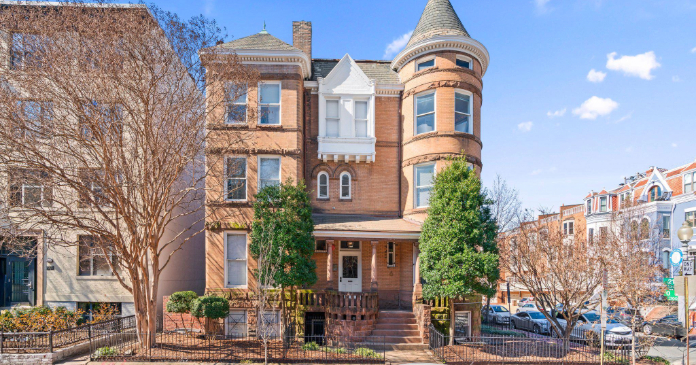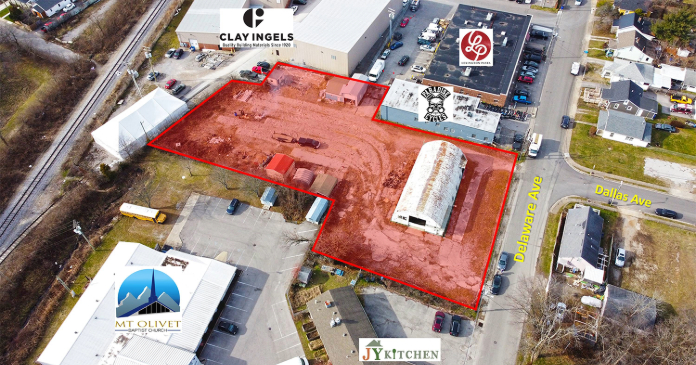But for the past several months, neighbors have watched as workers in hard hats cleared decades worth of trash from the 80,000-square-foot building, which was built in 1874. Workers have installed new plumbing and are working on renovations that will maintain the building’s status as a historic structure.
The builders are following the vision of developers Donald Manekin and his son, Thibault, who describe the work as an example of the kinds of “socially conscious” real estate projects they hope to continue to do in Baltimore through their Seawall Development Corp.
Their plan is to take advantage of the building’s multiple floors, high ceilings and exposed brick walls and convert about a third of the structure into affordable, environmentally friendly office spaces for small nonprofits — of which Baltimore has plenty. The rest of the building will be devoted to satisfying another steady market: affordable rental housing for teachers.
“It was terrible until they came and took it over and said they were going to make it apartments for teachers,” said Stephanie Forsythe, who has lived a few doors from the building for seven years. She complained about people using drugs in the building in the past and about trying to keep the alley behind it from clogging with trash.
Of the plan for the building now, “everybody likes it,” Forsythe said.
“Now they look up to the building. It’s getting fixed. It’s a good thing for the neighborhood.”
The redevelopment of the H.F. Miller and Son Tin Can Manufacturing Plant, in the 2600 block of N. Howard St., is expected to cost about $20 million. The new place will be called Miller’s Court. The project is benefiting from an increasingly popular development tool known as the New Markets Tax Credit, which city developers have tapped in the past to revitalize such sites as Belvedere Square and the Hippodrome Theatre.
The planned redevelopment of the American Brewery building and the construction of a large biotechnology research park, both in East Baltimore, are also benefiting from the tax break, which consists of a
39 percent tax credit over seven years. Since it was approved by Congress in 2000, the credit has been used by developers in Baltimore and across the country to defray the financial risk of building projects in communities facing economic distress.
The developers received historic tax credits because the building is on the National Register of Historic Places, and obtained a pair of economic development loans totaling $1.4 million from the city and state.
But the tax credits — particularly the New Markets Tax Credit — were key for Miller’s Court, according to Suzanne C. Brown, a director with a subsidiary of Enterprise Community Partners in Columbia, which helped the developers receive the credits.
The developers “would not have been able to attract enough commercial market-rate capital that would fill their entire need for construction costs” without access to these two tax credits, Brown said.
With the finances of the project solidified, the Manekins hired Hamel Builders and Marks, Thomas Architects to oversee the building’s transformation from eyesore to habitable space for renters and workers. Construction workers broke ground at the site in April and have completed lead-paint abatement, the installation of some plumbing and a major cleanup of trash and debris.
One part of the building is three floors and will house 25 nonprofit offices; another portion is four floors, and will comprise 40 one- and two-bedroom apartments, the developers said.
Donald Manekin, who served as chief operating officer for the Baltimore City public school system several years ago, said that every year, hundreds of new teachers arrive in Baltimore, and part of the project is geared toward them.
Thibault Manekin said they received advice from teachers on what amenities the building should have, and architects are adding fun touches, such as a fire pit and a bocce court in the building’s courtyard.
The developers quickly learned that constructing a dormitory-style building wouldn’t appeal to teachers, so instead, the architects are designing trendier loft-style apartments.
Common-area “planning rooms” are also slated for each residential floor, where teachers can use copy machines — instead of running out to a copy center late at night — and prepare lesson plans, Thibault Manekin said.
“They should have the red carpet rolled out to them,” he said of teachers who choose to work in Baltimore. “And this is what this project is all about.”
Technically, the apartments can be rented by anyone, but the Manekins are focused on marketing the units to school teachers.
The father-son team also tapped its connections with city nonprofits that work with the education system to get a sense of their needs.
They saw the building, which they bought last year for $2.5 million just before a bank was going to foreclose on its owner, as a natural fit for nonprofits seeking reasonably priced office space.
They already have commitments from nonprofit entities to occupy all 25 offices planned for the building, Donald Manekin said.
“We’re really excited about it,” said Pam Spiliadis, executive director of the Baltimore Urban Debate League, a group that teaches debate skills to city students. It expects to move into the building when it’s completed next summer.
“It’s fantastic for us because a number of nonprofits organizations that work in the education field are going to be housed there. And I think it’s going to facilitate us doing some powerful things in the city together,” Spiliadis said.
Joan Floyd, president of the Remington Neighborhood Alliance, said residents are excited about the development’s focus on teachers and nonprofits connected to education, because the neighborhood has started to lobby the city for its own pre-K through eighth-grade school.
“The prevailing attitude is that everyone wants it to be a success,” said Floyd, who noted that the community used to complain to the city about the building’s poor condition. “The community wants it to be a success. They want to see people move in, and they want to see these education-oriented people coming into Remington.”
Author: Gus Sentementes, Baltimore Business Journal
















